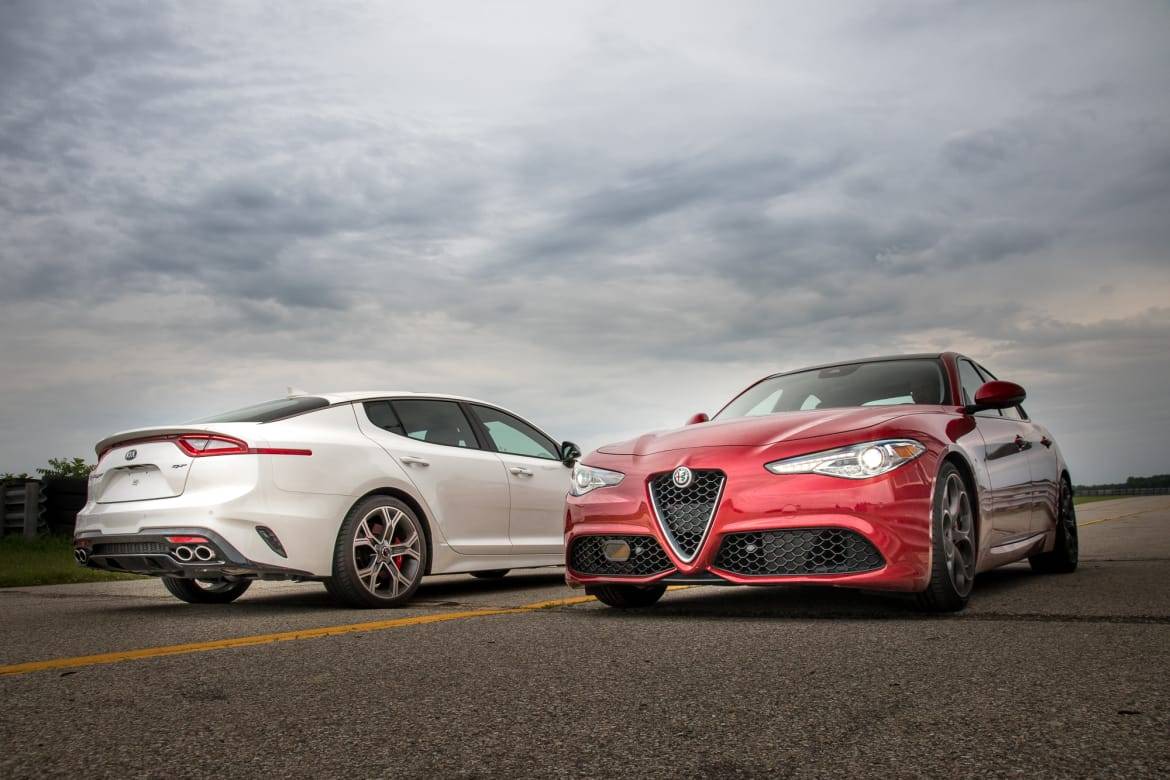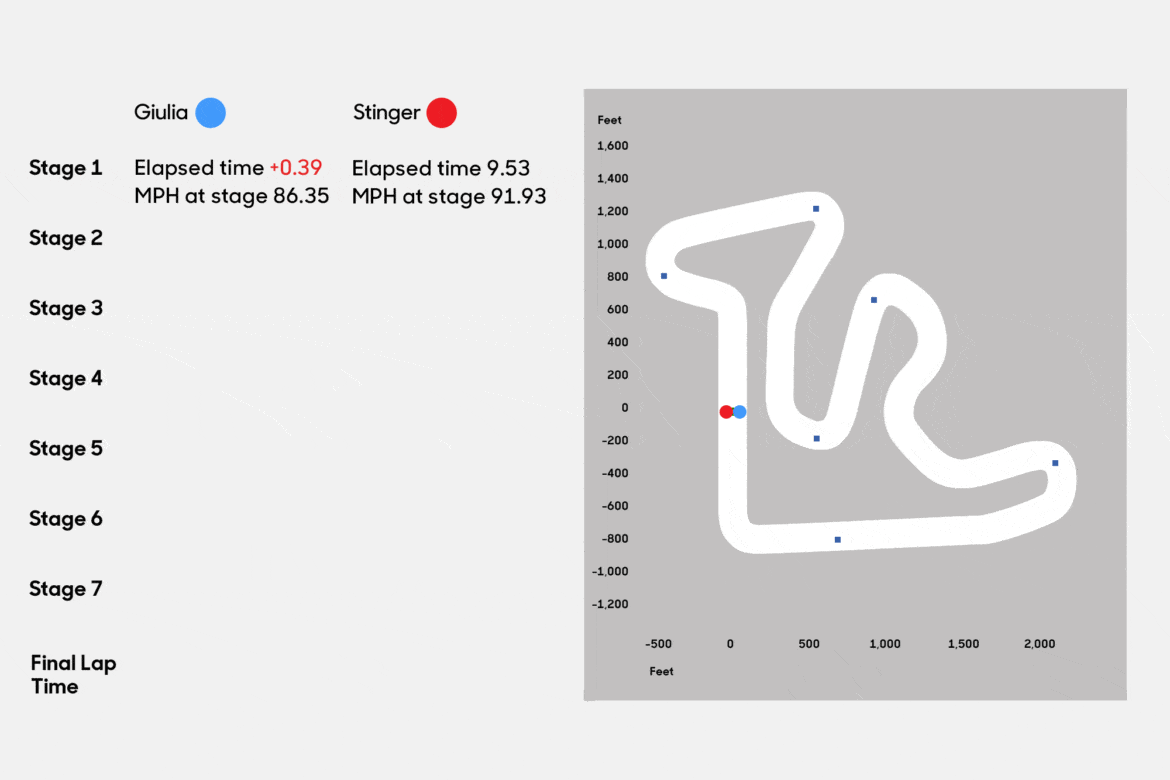Kia Stinger GT Vs. Alfa Romeo Giulia Ti: Who Does Luxury and Lap Times Best?


If one thing’s clear about the Kia Stinger GT, it’s that it doesn’t have a clear competitor. There just aren’t many mid-sized, twin-turbocharged, V-6, rear-wheel-drive hatchbacks out there. Absent an exact match, we humbly suggest the Alfa Romeo Giulia Ti. Both are new players in the sports sedan-ish game, and we can connect the dots: Kia hired the former vice president of engineering for BMW’s M Performance division to lead high-performance development at Hyundai-Kia, and the Giulia stole the crown of best-driving sedan from BMW in Cars.com’s 2017 Luxury Sports Sedan Challenge.
OK, it’s a stretch, but the matchup makes sense — that is, dollars and cents. As-tested pricing for the Stinger GT was $50,100, and the Giulia Ti was $51,990 (all prices include destination charges).
Related: Braun Vs. Brawn: BMW M4 Vs. Ford Mustang GT Performance Pack 2
Part of our test was to see if the cars deliver on their sporting intentions by driving both at GingerMan Raceway in South Haven, Mich., and testing acceleration and braking at Great Lakes Dragaway in Union Grove, Wis. These aren’t track cars like a Honda Civic Type R or Ford Mustang GT with Performance Pack 2, but we had a professional track instructor, Hollie Heiser from CGI Motorsports, give us her 2 cents on how these cars handled the 2.14-mile GingerMan road course. We also considered interior room and quality, street manners, multimedia system intuitiveness and cargo room to add it all up and see which is the best way to spend $50,000.
Below, the judges for this test — Cars.com reviewers Aaron Bragman, Mike Hanley and me — discuss the biggest takeaways after side-by-side testing.
Acceleration
Both cars are rear-wheel drive with limited-slip differentials helping plant power from turbocharged engines. Granted, the Kia has double the turbos and two extra cylinders for 365 horsepower, an 85-hp advantage, but the Giulia is smaller and lighter — and by no small margin.












The Giulia’s 280-hp, turbocharged 2.0-liter four-cylinder is matched well to the compact sports sedan’s lightness, while the 3.3-liter V-6 in the Stinger GT packs more punch for the buck. In acceleration testing, the Giulia was a full second slower both to 60 mph and to cross the finish line in the quarter-mile. Zero-to-60 mph came in 4.82 seconds for the Stinger versus 5.79 seconds for the Giulia thanks to a trick launch control on the Kia that overcame its otherwise sluggish take-off. In the quarter-mile, the Stinger stretched its legs with a 13.11-second elapsed time at 107.67 mph versus the Giulia’s 14.11-second time at 99.25 mph. The numbers didn’t tell the whole story, however.
Bruzek: This is a case where the disparity in measured performance felt smaller as interpreted by my butt dyno. I didn’t think the Giulia’s acceleration was significantly less entertaining than the Stinger’s. The eight-speed automatic transmission is the savior, keeping the Alfa’s slightly laggy four-cylinder engine in the mid-range where it’s most potent and responsive. Being 400-plus pounds lighter also helped the Giulia make up its horsepower disadvantage around town; we measured the Stinger at 3,995 pounds and the Giulia at 3,585 pounds. But lay into the gas and the Stinger really shows off its extra guts once its two tons get moving.
Hanley: The Stinger GT’s V-6 delivers a big wave of power that’s easily accessible on the street, and it gives the Kia the kind of effortless acceleration that’s expected of a performance luxury sedan. The Giulia’s four-cylinder, however, is surprisingly stout, and I agree with Joe that the Alfa’s transmission deserves a lot of the credit. The Giulia’s automatic is beautifully matched to the four-cylinder, delivering succinct, appropriately timed shifts. It’s not that the Stinger GT’s transmission is a slouch, it’s just that the Alfa’s is that much better.
Bragman: This is kind of a brains-versus-brawn argument, with the Kia bringing muscle to the party with its big V-6 and the Alfa bringing software with its beautifully tuned automatic transmission. The thing is, you’re still having a party regardless of which one you’re driving. Neither of them feels slow by any means, and they get still quicker-feeling when you put either of them in Sport mode and change how their transmissions and throttle inputs react to your foot.
Handling
The Stinger GT with the GT2 trim has a stout handling package, including adaptive shock absorbers with adjustable firmness settings, the limited-slip differential and summer Michelin Pilot Sport 4 tires. Our Giulia was equipped with an optional Ti Performance Package with adaptive dampers and limited-slip differential plus 19-inch wheels with Pirelli P Zero summer tires. While it’s not a must-have because the Giulia is already capable without the package, this equipment takes the car to new levels of handling goodness.


















JB: The Giulia’s eagerness to happily dance from corner to corner reminded me of driving the Honda Civic Type R, which we were track-testing the same day. The Giulia’s quick reflexes, sharp handling and composure matched that of a dedicated sports car. I loved driving the Giulia spiritedly both on the track and on back roads. The Stinger didn’t have quite the Giulia’s gracefulness, and it felt out of place trying to match the Alfa’s capabilities. Its composure was floaty at high speeds; I wanted one or two more levels of aggressiveness from the GT’s adaptive suspension, like a Track mode instead of the top Sport mode. The bones felt good, but the Stinger needs tightening up to be on the same level as the Giulia.
MH: Agreed. The Giulia’s steering tuning is just a lot sharper and more immediate, while the Stinger GT’s is more relaxed. The Stinger’s suspension is a little more compliant than the Giulia’s, which is firm in its Normal mode and harder-riding — though not harsh — in Dynamic. The setup makes the Alfa a lot of fun on the street, but it was tricky to drive on the track; I had a hard time adjusting to the Giulia’s quick steering and ended up making a lot of small steering corrections in corners. Still, it felt more at home on the track than the Stinger GT with its excessive body roll. There’s no question the Giulia is the sports sedan in this comparison and the Stinger is the grand tourer.
AB: It just goes to show you what an influx of BMW engineers can do for a brand. The resulting car acquits itself well on the street, but I found it floaty and heavy-feeling compared with the Alfa Romeo on the track. There’s no getting around the fact that the Kia has a mass disadvantage; the same qualities that make it a comfortable grand tourer for five occupants out in the real world keep it from being the excellently balanced, light-on-its-feet sports sedan that the Alfa most certainly is on the track.
Braking
While both cars use Brembo-brand brakes, the Stinger GT’s brakes are beefier on paper with larger rotors front and back, and two-piston rear calipers versus the Giulia’s single piston rears. (Both cars have four-piston front calipers.) Despite the larger hardware, the lighter Giulia out-stopped the Stinger in 60-to-zero-mph testing, stopping in 116.9 feet versus the Stinger’s 119.2 feet. That’s far from the end of the matter, however.






JB: If the Stinger’s suspension needed an extra level or two of stiffness to be on par with the Giulia, then its brakes needed about four or five levels more. The Stinger’s brakes start off with the mushiness of a commuter sedan’s brake pedal instead of the firm, precise brake pedal in the Giulia, but after a few laps on the track, it went downhill. The brake pedal pushed farther to the floor, losing firmness, and then the pedal started pulsating at the top of GingerMan’s backstretch where speeds approached 116 mph. Neither the Stinger nor Giulia are dedicated track cars, but the Giulia feels like it could be thanks to its consistent braking performance.
MH: Both cars have Brembo-brand brakes, but like Joe said, their effectiveness is significantly different. While the Stinger GT’s brake-pedal linearity is good, on track the car didn’t feel like it had a performance brake system. Whether it’s the system’s tuning, the Kia’s extra weight or something else, the Stinger GT’s brakes are, from a performance standpoint, one of the car’s most significant shortcomings.
AB: The brakes really are the Kia’s weakest link. They simply aren’t up to par — one should be able to take one’s sporty sedan to a track and enjoy at least a day’s worth of mild circuit driving without experiencing dangerous brake fade after just a couple of laps. That kind of behavior in a minivan I can understand, but it’s inexcusable in a car with the Stinger’s sporting pretense.
Occupant Comfort
Despite being nearly 8 inches longer than the Giulia, the Stinger is rated with similar interior room. We find it hard to believe that the Giulia’s 95.4 cubic feet of interior volume was taken using the same methodology that netted 94 cubic feet of volume from the roomier Stinger, especially after spending hours behind the wheel of both.
JB: The Giulia drives like a sports coupe, but it also has the interior room of one. Going from the Giulia’s backseat to the Stinger’s is like moving from a studio apartment to the penthouse. In the back of the Giulia, I pointed my head toward the panoramic moonroof recess to get the headroom I needed; I’m 6 feet tall. Speaking of comfort, the Stinger’s ride quality is a better fit for relaxed, casual driving than aggressive cornering like the Giulia, so it’s the comfort champ here.
MH: I like the Giulia’s optional front sport seats. They’re supportive, comfortable and include manually adjustable thigh support. The Stinger’s seats are similarly comfortable, and while neither car has great headroom, the Stinger’s backseat is slightly more comfortable; its backrest isn’t as upright as the Giulia’s. The Stinger’s swoopy styling hurts it here: The rear roof pillars and driver’s-side B-pillar restrict visibility.
AB: I simply can’t sit in the Giulia’s backseat. I can’t physically fit my feet into the footwell. The ceiling is also quite low and is exacerbated by an intruding moonroof, so I’m squished down in the front seat just to fit with a helmet on. It’s obvious the Stinger and the Giulia are in two different size classes here despite their similar rear-wheel-drive layout. The Stinger is clearly the comfort king.




































Interior Quality
This should be no contest; Kia makes economy cars and Alfa makes luxury cars. Plain and simple, right? Nope. The Stinger’s luxury game is strong with a head-up display, Nappa leather upholstery, power tilt/telescoping steering wheel, heated and ventilated seats, and more. Plus, the interior is well-put-together with fine materials, too.
JB: The Kia’s interior overachieves for a non-luxury brand, and the Alfa Romeo’s interior underwhelms from a luxury one, so they’re surprisingly close regarding materials and fitment. I give the edge to the Kia with its finer details, like its use of brushed-silver highlights that give the interior a more premium feel than the Giulia.
MH: The Giulia might be priced like a luxury sedan, but apart from the optional aluminum shift paddles affixed to the steering column (which are about as good as you’re going to find anywhere), the cabin doesn’t feel that luxurious. Instead, it’s understated and purposeful — the main purpose being driver involvement. Joe’s right that this gives Kia an opening, as the Stinger impresses with authentic materials and a premium feel. It’ll wow shoppers who haven’t been in a Kia recently.
AB: I’m actually rather disappointed that Alfa Romeo didn’t send us a car with the upgraded interior — there are a couple of options that add a significant amount of color to the Giulia’s interior, and even one that has green and white stitching that looks fantastic. But the Alfa we got was basic black inside, and while it’s cleanly designed and decently screwed together, the Stinger’s interior is far more premium and expensive-feeling.
Multimedia Systems
Multimedia systems are more than simply playing music because they intertwine vehicle settings and controls into their screens, so it’s impossible to avoid using these sometimes overly complicated interfaces. The Stinger GT reflects Kia’s roots as a car for the everyday person with an intuitive layout of volume knob, tuning knob and large touchscreen. The Alfa, on the other hand, has a center dial knob for control of non-touchscreen display.












JB: The multimedia system and controls further support that the Stinger is easier to live with daily. Its large touchscreen is supplemented by volume and tuning knobs, it has an easy-to-navigate user interface and standard Apple CarPlay and Android Auto; we tested a 2017 Giulia, so it didn’t have Apple CarPlay or Android Auto, but that comes optional on 2018 Giulias, and it’s standard for 2019 models.
MH: At first glance, the sleek black panel in the middle of the Giulia’s dashboard looks like a large screen, but the multimedia system uses only a portion of the space and its graphics aren’t the sharpest. The Giulia’s console controller knob works well enough once you get used to it, but it can’t match the Stinger touchscreen’s ease of use.
AB: Where the heck is the Fiat Chrysler Automobiles Uconnect system? It’s in all of the Maseratis now, so why not this Alfa Romeo too? The system we’re stuck with here is awful, with a strangely grainy screen that feels murky and dark due to the polarized screen. The Kia is clearly the winner in this category, too, featuring a fully modern system that’s clear, easy to use and that offers up the latest Apple and Android options in case you’d rather go with their interfaces instead.
Track Laps With Hollie

Even though laps times favored the Stinger GT, Heiser scored the Stinger GT a 3 out of 10 because of its braking issues, which plagued her lap times and comfort on the back stretch. “Out there, you need to be able to be confident in your brakes, and I wasn’t,” said Heiser of her laps in the Stinger. The Stinger cracked off faster laps thanks to big straightaway speed of up to 116 mph versus the Giulia’s maximum 106 mph. The Giulia shone in cornering, however, with consistently more grip and higher cornering speeds where it closed the gap on the Stinger. It wasn’t enough, though. The Stinger’s best lap took 1:52.48 versus the Giulia’s 1:55.53.
Winner: Kia Stinger GT




















The Stinger GT is a secret luxury car with surprise features for the money, which combined with its acceleration advantage to give the Stinger GT an edge in this test with 244 points to the Giulia’s 242 points.
The Stinger GT pummeled the Giulia in our standing tests of interior quality, cargo storage, occupant comfort, and controls and multimedia, as well as measured acceleration and track lap times, while the Giulia fought back in seat-of-the-pants performance categories of braking, handling, fun to drive and by our pro track instructor’s score of track ability. Considering how close the cars are in price and final scores, they couldn’t be more different in their approach.






Cars.com’s Editorial department is your source for automotive news and reviews. In line with Cars.com’s long-standing ethics policy, editors and reviewers don’t accept gifts or free trips from automakers. The Editorial department is independent of Cars.com’s advertising, sales and sponsored content departments.

Managing Editor Joe Bruzek’s 22 years of automotive experience doesn’t count the lifelong obsession that started as a kid admiring his dad’s 1964 Chevrolet Corvette — and continues to this day. Joe’s been an automotive journalist with Cars.com for 16 years, writing shopper-focused car reviews, news and research content. As Managing Editor, one of his favorite areas of focus is helping shoppers understand electric cars and how to determine whether going electric is right for them. In his free time, Joe maintains a love-hate relationship with his 1998 Pontiac Firebird Trans Am that he wishes would fix itself. LinkedIn: https://www.linkedin.com/in/joe-bruzek-2699b41b/
Featured stories










